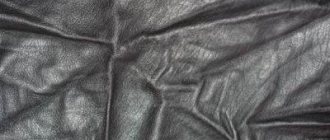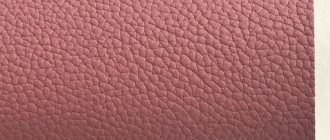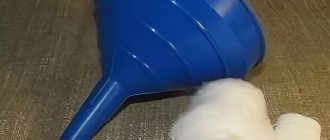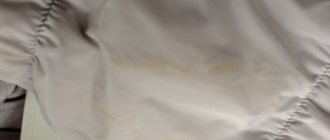You can reduce the size of almost any item of clothing by correctly combining temperature and spin in a manual or automatic washing machine. Wool and silk are delicate fabrics that should not be subjected to sudden changes in temperature or high spin speeds. Synthetic fabrics, as well as jeans and cotton, on the contrary, change size with a sharp alternation of hot and cold water. It is important not to overdo it so that the processing does not deform the clothes and ruin their color irrevocably.
Washing them incorrectly or wearing the same item in your wardrobe for a long time can cause stretching, making it unsightly and uncomfortable. To restore your clothes to their former glory, learn how to wash a piece of clothing so it shrinks but doesn't ruin it.
When does the wool “shrink”?
A material such as wool, due to its naturalness and natural characteristics, can easily be modified under the influence of various sources. First of all, woolen items shrink when washed at high temperatures . Natural hairs curl, compact and “fall off”, which makes the product warmer, but significantly reduces its size.
Important! Items containing both real wool and artificial fibers can behave completely differently. Some things containing synthetics do not shrink at all, some only stretch. Therefore, for products with a mixed composition, methods typical for natural woolen items may not always be suitable.
Resizing by suturing
An option that is suitable for products evenly stretched around the entire perimeter. This method will only take a few minutes and will allow you to significantly modify the item, giving it the desired shape and adjusting the size.
To implement this method, you will need, first of all, a needle with a thick thread in the color of the product, as well as pins with which you will need to highlight the silhouette:
- turn the item inside out and try it on yourself in front of the mirror;
- determine the desired shape and, using pins, carefully secure the desired shape on the sides , trying to release the material evenly. If necessary, you can baste the resulting silhouette with a thread with a contrasting, brightly eye-catching color;
- select a thread of sufficient density and a suitable shade that would blend in with the yarn, and use wide stitches to sweep away the future shape obtained after trying on the product;
- try on the item again, turning the item right side out . After making sure that the product fits as it should, sew the basted stitches on a sewing machine, selecting the standard stitching program and making the stitch length medium - about 0.7 cm;
- Carefully trim the excess material with scissors , not forgetting to leave about 1 centimeter for finishing the edges. This must be done so that the fabric does not begin to crumble and fall apart;
- finish the edges along the entire product using an overlock stitch or zigzag , then turn the item inside out and try it on again.
This method is recommended to be used to reduce the item by no more than two sizes, since too much suturing can warp the item, after which it will need to be completely altered and recut.
Washing rules to make woolen items shrink
In order to “plant” a knitted item, you need to pay attention to several parameters. If you follow all of them, you will be able to carry out the procedure without incident, as a result of which you will have a sweater of the ideal size.
Temperature
First, pay attention to the label on your item, as the temperature at which it should be washed is always written above it. Since we are pursuing slightly different goals and want the product to change slightly, we should “conjure” with the temperature regime. Typically, the optimal temperature for washing wool is 30–40 °C , but we need to increase it by 20 °C to make clothes smaller.
Mode
The best option is to wash the item by hand . However, if you are lazy or simply don’t have enough time, use a washing machine. To do this, set it to one of the following modes:
- "wool". Its settings are usually set to a small number of revolutions. This is a good feature because at high speeds a wool sweater can change from adult to child size;
- “hand wash”, “children’s mode”. These programs are also quite delicate, so they are suitable for washing.
Hand knitted item
The problem with hand-knitted items is often that there may not be a tag on it indicating the specific material and the required washing temperature . If you are sure that the hat you bought from a craftswoman is truly completely natural, then you can try reducing its size by steaming. Do this through a cloth so as not to damage the delicate texture. If you do not have accurate information about the composition of the yarn, then it is better to wait with steaming. Try reducing it using the washing method.
Machine knitted item
An important feature of wool products is that they will retain the shape in which they dry . Therefore, if dried incorrectly, even machine knitting can suffer and stretch. This can be corrected by drying the sweater again. For this:
- wash the sweater or just soak it well in water. It must be completely saturated. If you are afraid that it will shrink very much in the water, then use a contrasting method: do not immediately soak the item in too hot water;
- After this, remove the clothing, but do not wring or twist it - this will damage the fibers again. It is better to place it on a flat surface (for example, in a bathtub, basin or on a special board) in a free position and allow excess water to drain;
- wrap it in a thick cloth or terry towel that will absorb unnecessary moisture. This method will replace traditional squeezing;
- change the fabric or towel, spread it on a flat surface, and place your sweater on top. Give it the desired shape, for example, lay a collar or adjust it in length. This is the form the product will be in when it dries.
Important! Wool takes a long time to dry; at room temperature it can dry for 2–3 days. Make sure that it does not acquire an unpleasant musty smell, so if necessary, change the towel on which it lies.
Reduce the size of a cotton sweater
I would like to say right away that this is the simplest task. After all, if you have never washed your cotton cardigan, you can immediately put it in the washing machine. After this, you will need to set the hot water temperature (60°), add washing powder that preserves the color of the product.
Upon completion of washing, set the normal spin cycle and then use machine drying. Iron the item washed in this way and you can safely try on your favorite item, which will no doubt fit you.
However, for cotton items that you just purchased, there is another very effective way to reduce the size. To do this, you will need an iron that has a steam mode. You only need to carefully (every centimeter) smooth out the cotton product. This way, your favorite cotton sweater will shrink much faster.
How to wash so that only the sleeves shrink?
If you are not satisfied with only the sleeves in a knitted product (for example, you pulled them unsuccessfully when putting on a sweater), then you can try to reduce only their length or width. For this:
- spray the sleeves with water from a special spray bottle or simply wet them carefully without touching other areas;
- lay the item horizontally again, straighten the sleeves and give them the required shape in length or width;
- wait for it to dry.
Advice! You can also try simply steaming only the sleeves. The main thing is that hot steam does not get on the main part of the blouse.
Tools and materials for work
Before starting work, you need to select and prepare the necessary tools and materials.
To remake a shirt at home you will need
- set of needles of different formats
- threads (different numbers and colors. Suitable ones are selected from them, depending on the structure and color of the fabric);
- scissors (large, small and medium);
- pins;
- thimbles (to protect fingertips);
- various accessories (buttons, decorative brooches, buckles);
- crayons;
- sewing machine;
- iron and ironing board.
Professionals also use:
- patterns;
- cardboard (thick paper);
- measuring tape;
- a box of wax (for waxing the thread);
- threader;
- cutter (special copy roller for making marks on the material);
- carbon paper (for transferring the drawing);
- transparent template ruler;
- overlock
How to wash something made from several different materials?
If the product contains both natural and synthetic materials, pay attention to the specific composition and recommended temperature conditions . Unfortunately, synthetic things are quite difficult to revive.
For example, it is almost impossible to shrink polyester. However, we advise you to try reducing the size of the item first only in those areas that have stretched. Also, do not immediately use extremely high temperatures - the wool contained in the composition may still shrink to child size. It is better to use the contrast wash method.
Reasons why a sweater may stretch
Old items may become deformed due to prolonged use. Even with proper use, clothes will not look new within 10 years of constant wear. Other reasons that cause thread stretching include:
- non-compliance with temperature conditions during hand washing;
- incorrectly set program on the washing machine;
- knitting features (large perforated pattern);
- habit of pulling on sleeves;
- improper storage;
- inappropriate detergent;
- improper drying, etc.
Ways to prevent woolen items from stretching after washing
In order to avoid the not-so-pleasant procedure of shrinking your favorite sweater, follow some rules during and after washing it:
- If possible, wash it in warm water by hand or use a delicate machine wash cycle;
- do not twist it when squeezing, let the water drain in its natural position;
- Do not dry the item in a vertical position: always lay it out on a flat surface;
- do not dry it on a hot radiator or in the open sun, as it will not only lose its shape, but may also fade;
- it must be ironed either through a cloth or by steaming without contact with the hairs;
- Do not dry or store knitted sweaters on hangers - they will definitely stretch out. It's better to keep them folded in the closet.
Which blanket is better - sheep's wool or bamboo?
Crafts from satin ribbons
Shrinking a sweater by dry cleaning
The simplest and fastest method to get rid of this problem is to go to a dry cleaner, where there is a special service for reducing stretched wool items. Using heat treatment or washing, specialists will return the product to its original appearance and desired size in a matter of minutes. However, this method can negatively affect the softness and brightness of the item , making the item scratchy and the shade dull. Therefore, when changing the shape of a colored or colorful wool item, it is advisable to ask dry cleaning specialists to add a product to soften the fabric, and also to use a gentle method to maintain color saturation.
Trimming the sleeves of a sweater
If the sweater is knitted with a large knit, then we will do the following manipulation:
- Measure the required length on the sleeve of the sweater.
- Clinging to one loop, we pull on it until the part in this place gathers “into an accordion”.
- We cut the drawn thread on both sides.
- The part splits into 2 parts.
- We wind the lower part into a ball.
- On the top part we put all the loops on a knitting needle or hook. Close as with normal knitting.
You can crochet new cuffs to finish off the sleeve beautifully.
Sewing the shirt at the shoulders
There are two ways to change the shoulder size.
Without using ripping
You need to do the following:
- Step 1. Using a measuring tape, measure the required length from the collar to the far shoulder line, draw a line here.
- Step 2. Draw with chalk a place for the future seam, which should end at the edge of the armpit line.
- Step 3. Fold the item in half and cut the fabric along the drawn line. If the instructions are followed correctly, the sleeves and body of the shirt should become separate pieces.
- Step 4. Pin the cut sleeve with the back and front. It is necessary to connect the parts so that there are no holes. Remember that the armhole size has become larger.
- Step 5. Sew the joined parts and iron. The product is ready to wear.
By tearing
You need to do the following:
- Step 1. Determine your desired shoulder length and mark it on the fabric. It is also necessary to draw a line that will be parallel to the seam of the sleeve.
- Step 2. Remember to check for symmetry, otherwise the sleeves will be different sizes.
- Step 3. At this stage, you need to open the seams and carefully flog the sleeves.
- Step 4. After cutting off the excess fabric, connect the sleeves and openings for them. Then the parts need to be double stitched.
For more precise instructions, use this video tutorial.
In order to rip the seam correctly and accurately, use a special seam ripper. To do this, insert its thin tip under the thread and pull it up. Do this operation with each stitch.
Remember that you can only rip a seam on one side.
Is it possible to cut knitted items?
This can be done using a regular needle and thread or, for example, a crochet hook, if you walk a chain of air loops along the vertical jumpers. By the way, you can avoid manual work altogether if you have a sewing machine - just lay zigzag stitches along an imaginary cut line.
Interesting materials:
What material is best for building a house? What material is better for a sliding wardrobe? What material is better for the walls of the house? What material is best for panties? What material is better for a country house? What material is best for an umbrella? Which continent is the coldest and why? What is the minimum length of service required to receive an old-age insurance pension starting in 2024? What password can you come up with for the Appstore? What password can you come up with for PayPal?
Reducing individual elements
If the elastic band on a sweater has stretched, i.e. not the entire product, but its separate part (sleeves, neckline), then it can be restored separately without subjecting the entire fabric to water procedures. The jacket should be laid out on a flat horizontal surface. Use a spray bottle to moisten problem areas. When the fabric gets wet, it should be pulled so that the threads move in the opposite direction from the stretch. You can secure this position with a pin or rubber band. The sweater is left in this position until completely dry.
If the cuffs or other parts of the product have not stretched much, after moving the threads to the center, you can speed up the process of removing excess moisture. You can dry the sweater using an iron. To avoid damaging the fabric, it is recommended to iron the product through a piece of gauze folded several times. You can use a terry towel, but with each new ironing you should cover the jacket with the dry side.
Another method that cannot always be used to make a sweater smaller; in most cases, it is suitable for those products that were independently knitted. You can unravel the stretched part and then bandage it. To avoid having to unravel the entire sleeve if only the cuff is stretched, it is recommended to give preference to a needlework style that involves knitting from the elbow to the hand. There are fewer problems with the neck. In most cases, it is knitted separately from the body of the sweater and then sewn on.
Nuances that can ruin a thing completely
The following can be detrimental to a knitted item:
- ironing;
- drying on a rope or radiator.
In these cases, the canvas may become deformed in such a way that it will be impossible to correct it.
Drying on a radiator is detrimental to knitted items
Video: how to irrevocably ruin a wool item
I once bought a synthetic sweater. I was still quite an inexperienced housewife at that time. I washed it by hand and hung it on a line to dry. As a result, I ended up with something very long. I had to think about what to do with this. Fortunately, either short dresses or what they now call tunics (I didn’t know such words then) came into fashion. In general, I found a matching belt, and simply turned the sleeve cuffs inside out and inserted an elastic band into the lower part. I want to say that I wore this mini-dress for quite a long time and was glad that I had come up with a second life for my mistake.
How to stretch their cotton clothes
Cotton is a material with a composition of natural fibers, so violation of the washing temperature or improper drying can cause the fabric to shrink.
To correct this unpleasant situation, you can use the following method:
- Pour hydrogen peroxide or vinegar into a container with water (3 tablespoons per 10 liters), soak clothes in the solution for 30 minutes.
- We place the soaked clothes on a dry towel and begin to stretch them to the desired size.
- Leave to dry. We perform the procedure 3 times.
During subsequent washing, choose only the correct mode and a mild detergent.
Wool clothing
Whether a wool sweater was initially baggy due to the wrong size, or whether the sleeves and edges have stretched out over time, it can all be corrected. You can make your clothes shrink by performing a few simple manipulations with them:
- Wash woolen items in hot water at a maximum temperature of 20 °C higher than the recommended temperature. Baby laundry detergent is best used as a laundry detergent. It will help maintain the structure of the fibers. The spin speed should not be more than 500-600 rpm.
- After washing, the product should be rinsed in water at a temperature of 40 °C mixed with a capful of fabric softener.
- Then rinse it again in water at a temperature of 50 °C, but without additives.
- For woolen products, contrast rinsing is also relevant, in which immersion in hot water can be alternated with soaking in ice water.
Washed wool items should be placed in the dryer. It needs to be turned on at medium power and left to work until the clothes are dry.
11 recommendations to avoid mistakes
The following tips will provide additional assistance when washing a pullover:
The water temperature when washing and rinsing a sweater should not differ significantly. Ideally it should be the same. When washing by hand, it is not advisable to use brushes. At the very least, it should have soft bristles. Liquid detergents for washing knitted clothes are preferable to powder detergents.
To ensure that the item retains its softness after washing, it is advisable to add vinegar or dilute fabric softener during the last change of water during rinsing. Any pullover or sweater should be washed inside out. This increases the likelihood of maintaining the appearance of the product. Products made from thick textured or fluffy threads cannot be washed with powder detergents. It is better to choose a gel that dissolves well and does not clog into the fibers. Not only hot, but also cold water is not the best choice for washing. The optimal temperature is 30°C, unless another parameter is specified by the manufacturer. Twisting such things is strictly prohibited. If the rule is not followed, the sweater may lose its shape. If it is necessary to remove stains from an item, it is recommended to use non-aggressive means, first checking their effect on an inconspicuous area. Detergent can be applied to the product only after preliminary dilution in water.
It is especially important to follow this rule when washing woolen, including fluffy items. Only clean and completely dried items can be stored for long-term storage.
When is it better to entrust the rework to a professional?
Skilled craftswomen independently handle any detail of sewing a standard garment. For them, a blouse is an easy material to work with due to several simple operations with a needle and a sewing machine.
If you don’t have firm confidence in your skills, then to guarantee results without throwing things away, it’s better to turn to professionals. They will do all the work quickly and efficiently.
What can be sewn from chintz
What to wear with plaid shorts
General Tips
You can reduce the size of clothes effectively and save money in a regular washing machine. Whether it is a shirt or a pair of denim trousers, the procedure can be equally successful and a person can get the size he needs without spending money on a tailor. But not every washing option may be suitable. To understand how to wash clothes so that they shrink, you need to know a few rules. Different materials shrink differently, so different methods must be used to shrink an item one or more sizes.
Before starting the procedure, you need to carefully examine the tags sewn to the back of the product and determine the material from which the item is made. For example, cotton shrinks the best, polyester shrinks the least, while leather and fur do not shrink at all. You also need to determine whether the material has been pre-soaked or pre-shrinked, as this will make it much more difficult to shrink in size by washing.
You can also use the tag to find out the recommended washing temperature. For example, wool should be washed at 40°C. It should be taken into account that the recommended temperature is also related to the durability of the textile paint. Because of this, after the procedure, the color of the clothing will be less bright. To soften the effect of fading, it is better to choose a powder for colored fabrics that prevents discoloration as much as possible. A pinch of salt will also help prevent fabric discoloration.
What is it made of?
Any task will be resolved faster if you determine exactly what can and should be done. In this case, your actions will largely depend on what your jacket is made of or knitted from. It is quite possible that it will be enough to simply wash it in water at a higher temperature than usual. And for cotton and linen, it often doesn’t matter at all whether the water in the basin is hot or warm. These materials tend to shrink. So give it a try. In any case, it won't be worse. Even if you have to alter the blouse, it must be clean.
A wool or fleece jacket can be washed at a temperature of about 60°C. But if the blouse is knitted from high-quality pure wool, such as angora or cashmere, you should not wash it in hot water. You, of course, will be able to reduce it, but the wool may mat and lose its appearance. If your item is machine knitted, look at the seam cuts. Their type determines how you will sew the product and whether this is possible at all.
The seams of machine knitted products can be finished with an overlocker. In this case, you can sew in the blouse, trim the seam allowances and overcast them
Methods for stretching shrunken items
Using solutions will help return cotton and wool items to the desired size and maintain their shape. To care for delicate fabrics, you should choose soft products so as not to spoil the clothes. Moisturizing the fibers with special compounds and solutions helps maintain the integrity of the item during stretching.
Using Hydrogen Peroxide
One of the easiest ways to help stretch sweaters that have shrunk is to use hydrogen peroxide. The solution softens cotton fibers and wool threads, so that when stretched the item does not lose its shape. It is enough to add 3-4 tablespoons of peroxide per 10 liters of water, soak the product, and then dry it.
A mixture of turpentine, ammonia and alcohol
An effective method of restoration using a multicomponent composition seems complicated only at first glance. In a container with ten liters of water, you need to dissolve 2 tablespoons of pure vodka and turpentine, and then add 6 tablespoons of ammonia. The sweater is kept in this solution for 10 minutes and then dried, shaping and stretching with your hands.
Application of acetic acid
Vinegar is often used to add freshness to clothes and soften the water when rinsing. The same product helps restore the size of a shrunken sweater. You can soak the clothes in a solution of acetic acid, or you can spray and dry the product with an iron with a steam function. The concentration of vinegar should not be high - 1 teaspoon per liter of water is enough.
Using hair rinse or conditioner
Hair care product helps restore the shape of shrunken or stretched hair. Thanks to a special composition containing moisturizing components, wool and cotton fibers become more flexible and elastic, so they easily take on the desired shape. It is recommended to add the product to the rinse water and then dry the product with steam.
Options for making your blouse size smaller
It is very easy to get rid of extra centimeters in a blouse. The details of the closure depend on whether the product is one-piece or not.
How to sew a blouse along the side seam
Sewing a blouse along the side seam is done step by step and in strict sequence:
- sewing can be done by removing 2 cm from each side;
- to fit the sleeve it is evaporated;
- then the armhole deepens on the front and then on the back;
- the sleeves are sewn into the blouse;
- We also turn the length by two centimeters.
Due to darts or additional tucks on the back
To make a blouse look completely perfect on your figure, you need to have good sewing and clothing design skills. It's great if you know how to work with darts. To improve blouses, you can use additional tucks in the back area.
If the sleeves are long, what should I do?
Every person has knitted items. They are comfortable, practical, and keep you warm in cool weather. But the problem is that their sleeves often stretch or sag.
It's okay, they can be carefully hemmed. Knitted fabric differs from ordinary fabric in its structure, so you need to be patient in order to beautifully process the bottom of this part.
If a machine-knitted sweater has long sleeves, then we will do this work.
Operating procedure:
- On the product with cuffs, mark the new length. For example, you need to shorten it by 10 centimeters, measure 10 centimeters upward from the cuff with a ruler, draw a cutting line with chalk, leaving 1-15 cm for sewing on the cuff.
- Cut off the cuffs and sleeve along the marked line.
- We put a needle on the machine for sewing knitwear, selecting the “knitted stitch” function. If there is no such needle, then we leave the same needle, put a “zigzag”, the width of the step is 1-2, and the length is 2-3 to get an elastic seam.
- We remove the front part of the car and put the sleeve on the protruding part. We process the cut part.
- If the sleeve is too wide, step back 1 cm from the edge, sew a line in wide increments, and tighten it to the required size.
- Place the cuff face to face on the finished edge and sew with a zigzag stitch.
- We process the cuts using an overlocker or by hand.
Viscose
Viscose is an artificial fabric, but not synthetic. It can be called a natural synthetic fiber.
It is very difficult to reduce the size of products made from such material. As a rule, this fiber is combined with other fabrics, so to make an item 1 size smaller you should wash it in a certain way.
The choice of method depends on the exact composition of the fabric. Through experimentation, manufacturers have learned to make fabric that resembles the structure of wool, cotton and linen.
How to wash viscose so that it shrinks?
- When cotton is added, it is washed at a high temperature, then wrung out and dipped in hot water with softener added.
- Wool requires a sharp change in temperature. First soak in hot water, then in cold.
Also, women often face the question of how to wash viscose so that it does not shrink. After all, such material shrinks a lot if not washed correctly.
To do this, immediately after removing all the dirt, when the item is still wet, put it on your naked body and walk around in it until it dries completely. The product will take the shape of a person.
To prevent things from shrinking, you need to wash them at the right temperature. It is usually indicated on the tag. You can also steam iron the product after drying.











